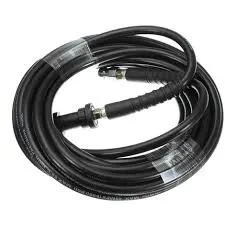Feb . 11, 2025 18:24
Back to list
power steering pump hoses
Power steering pump hoses play a critical role in the efficiency and functionality of a vehicle's power steering system. As a core component, these hoses are designed to transport hydraulic fluid to the power steering pump and gear, enabling drivers to maneuver their vehicles with ease. Understanding their importance, types, maintenance tips, and potential issues can considerably enhance vehicle performance and longevity.
Replacing power steering pump hoses should be carried out promptly at the first sign of damage. Before replacing, ensure the vehicle is turned off and cooled down. Carefully relieving the pressure in the system prevents fluid sprays. Using the correct type of hose and fittings during installation minimizes risks. Tightening connections firmly yet cautiously avoids potential leaks and damage. It's wise to refer to the vehicle’s manual for specific installation guidelines or consult with a certified mechanic if uncertain. Understanding the common problems associated with power steering pump hoses can help in troubleshooting potential issues early. Leaks are a prevalent issue, often stemming from cracks or loosened fittings. Over time, exposure to engine heat and hydraulic fluid degrades hose materials, leading to compromise. Observing differences in steering responsiveness, increased effort to steer, or unusual whining noises when turning can hint at a failing hose in need of prompt attention. Many vehicles today incorporate electronically controlled steering systems that, while reducing reliance on hydraulic systems, still utilize power steering pump hoses. In such setups, the longevity and performance of the hoses remain as integral as ever. The emergence of eco-friendly hydraulic fluids designed to be less abrasive on hoses contributes to reducing environmental impact and enhancing hose lifespan. In conclusion, maintaining and understanding power steering pump hoses is critical to vehicle safety and performance. Ensuring you purchase high-quality parts, routinely performing inspections, and addressing problems early on can save significant headaches and expenses down the road. Whether experienced in automotive repairs or a novice, appreciating the nuances of power steering pump hose maintenance can equip you with the knowledge to make informed decisions, fostering a safe and efficient driving experience.


Replacing power steering pump hoses should be carried out promptly at the first sign of damage. Before replacing, ensure the vehicle is turned off and cooled down. Carefully relieving the pressure in the system prevents fluid sprays. Using the correct type of hose and fittings during installation minimizes risks. Tightening connections firmly yet cautiously avoids potential leaks and damage. It's wise to refer to the vehicle’s manual for specific installation guidelines or consult with a certified mechanic if uncertain. Understanding the common problems associated with power steering pump hoses can help in troubleshooting potential issues early. Leaks are a prevalent issue, often stemming from cracks or loosened fittings. Over time, exposure to engine heat and hydraulic fluid degrades hose materials, leading to compromise. Observing differences in steering responsiveness, increased effort to steer, or unusual whining noises when turning can hint at a failing hose in need of prompt attention. Many vehicles today incorporate electronically controlled steering systems that, while reducing reliance on hydraulic systems, still utilize power steering pump hoses. In such setups, the longevity and performance of the hoses remain as integral as ever. The emergence of eco-friendly hydraulic fluids designed to be less abrasive on hoses contributes to reducing environmental impact and enhancing hose lifespan. In conclusion, maintaining and understanding power steering pump hoses is critical to vehicle safety and performance. Ensuring you purchase high-quality parts, routinely performing inspections, and addressing problems early on can save significant headaches and expenses down the road. Whether experienced in automotive repairs or a novice, appreciating the nuances of power steering pump hose maintenance can equip you with the knowledge to make informed decisions, fostering a safe and efficient driving experience.
Latest news
-
Reliable Brake Line Solutions for Your VehicleNewsJun.05,2025
-
Quick Fix for Leaky Air Conditioning HosesNewsJun.05,2025
-
Powerful Sewer Jetting Solutions for Tough ClogsNewsJun.05,2025
-
Power Steering Hose Problems SolvedNewsJun.05,2025
-
Hose Protectors That Actually WorkNewsJun.05,2025
-
Essential Hose Connectors for Every HomeNewsJun.05,2025

